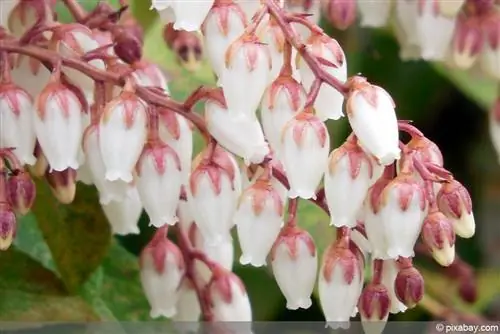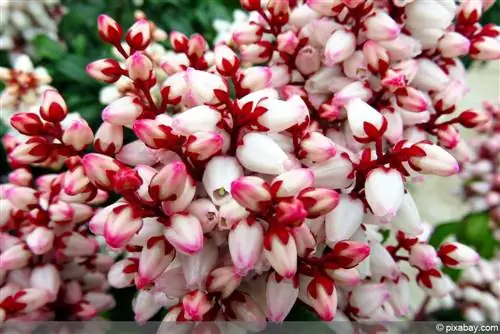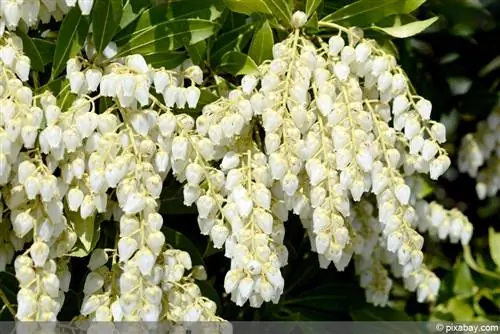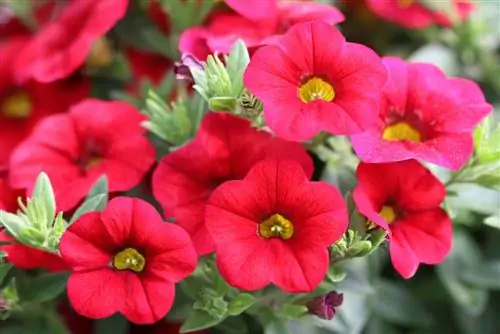- Author admin [email protected].
- Public 2023-12-17 03:39.
- Last modified 2025-01-24 12:45.
The lavender heather, with the botanical name Pieris, is evergreen and is an eye-catcher, especially in winter, with its foliage and flowers. It is popular with bees and can be used as a hedge. It is also comparatively easy to care for, although certain details must be taken into account. Because the shadow bell, as the lavender heather is also called, has special demands on the location and substrate as well as the culture in the garden or pot.
Location
It should be sun or at least light shade for the lavender heather. If the shrub is too dark, it loses flowering power and produces more foliage. It should also be noted that, depending on the variety, it can grow between two and four meters high. The height and width of the plant should be taken into account when choosing a location.
The rule of thumb is that a distance of half a growing width from other plants should be maintained. It is also important to ensure that the shade bell is not exposed to the blazing midday sun and is also protected from cold wind. An eastern orientation or a location near a wall is therefore favorable.
Substrate
Like azalea and rhododendron, lavender heather prefers acidic soils with a low lime content. In addition, the substrate should meet the following requirements:
- loose and well-drained, not prone to compaction
- slightly damp but not wet
- pH value of about 5
- humos
- only moderately nutrient-rich
A mixture of garden soil and peat in equal parts is ideal. Alternatively, ready-made rhododendron soil can also be used.
Plants
The lavender heather is best planted between August and September. With regular watering, it can grow well until the beginning of winter.
If the shadow bell is to serve as a hedge, half the growth width is maintained as the distance between the plants. If the soil does not meet the requirements, a planting hole at least 50 centimeters deep and wide should be dug and the appropriate substrate filled in.
Pouring

Keeping the lavender heather slightly, consistently moist until autumn is recommended and prepares the plant for the winter. However, waterlogging is to be avoided at all costs, as is hard water with a high lime content. Rainwater, pond water or soft tap water should therefore be used. If the tap water is very rich in lime, it can stand for a week. The lime collects on the ground. The water is then poured so that the sediment remains in the container.
Fertilize
The lavender heath can be fertilized with the new shoots in spring. Suitable for this:
- Peat
- Bark humus
- Rhododendron fertilizer
Humus and peat can be added to the substrate and easily incorporated. They also have the advantage that they have a positive effect on the pH value of the soil. A single dose of nutrients per year is usually sufficient. If necessary, this can also be divided into two doses, with the second fertilization taking place in June to July at the latest.
Blend
The shadow bell grows comparatively slowly. An increase of up to eight centimeters can be expected per year. Of course, the speed of growth also depends on the variety you choose. Cutting is therefore often not necessary for a long time, but is tolerated well by the lavender heather. Ideally, the measure is carried out after flowering, with withered inflorescences and crossing shoots being removed.
In this way, the branches receive enough light again. When cultivated as a hedge, the shrub can also be shortened all around. It is recommended to shorten shoots one to half a centimeter in front of an outward-facing flower. Cut diagonally so that the tip points away from the bud. However, very old and bald shoots are cut off or sawn off just above the ground.
Tip:
Gloves must be worn when cutting, as all parts of the lavender heather are poisonous. For this reason, the clippings should be disposed of in such a way that they are not accessible to children and animals.
Propagation
The lavender heath reproduces on its own by forming runners. The easiest option is to leave these runners on the mother plant for as long as possible so that it has already developed roots itself. Then proceed as follows:
- Carefully remove the substrate and cut the connection to the mother plant close to the large plant.
- Also carefully remove the soil from the roots so that they are not injured. Damaged root runners must be cut off.
- The young plant is planted and watered as described above.

Alternatively, the runners or shoots about ten centimeters long can be cut directly from the mother plant and freed from the lower leaves. These are placed in moist potting soil and can be placed in the same substrate as the mother plant when new leaves emerge.
Again, gloves should be worn to avoid skin contact with escaping plant sap.
Tip:
The formation of runners can be accelerated by bending longer shoots that are close to the ground downwards and burying a section of them in the ground about 20 centimeters in front of the shoot tip. Roots subsequently form in the area covered with soil.
Wintering
The evergreen shade bells do not require any protection in winter as long as they have been planted freely in the garden. In dry winters with strong sunlight, it can also make sense to protect the leaves with a layer of garden fleece. Cultivated in a pot, the lavender heather needs protection from frost and direct winter sun. It also needs to be protected from drying out. On the one hand, it can be overwintered in a frost-free but cool and bright room, for example in an unheated hallway or a cellar directly in front of a window.
On the other hand, it is also possible to insulate the bucket from below with Styrofoam and all around with garden fleece and to leave the lavender heather outside. In any case, care should be taken to ensure that the substrate does not dry out completely. A small amount should therefore be watered outdoors on frost-free days and indoors about once a week.
Diseases, pests and care errors
Root rot and the web bug are particularly problematic for the lavender heather. Risk factors for root rot include:
- Waterlogging or insufficient water drainage
- substrate prone to compaction
- cold, heavy soil
If the shadow bells are infected, the foliage turns yellow and wilted. The plant barely grows or even cares. As a preventative measure, you should pay attention to the right substrate and, if necessary, add a drainage layer and adjust the watering behavior. If root rot already exists, the following measures can help:
- Offcuts of the affected and dead plant parts
- Use of sulfur preparations as soil disinfectants
- Application of fungicides
- Replacing the substrate and moving to a drier location
In terms of pests, the web bug mentioned above is problematic. The adult parasites suck the leaves of the lavender heather starting in spring and later lay their eggs on them. In addition to the animals themselves, which are approximately three millimeters long, they can also be recognized by:
- point discoloration on the leaves, which eventually become completely yellow or brown
- black deposits
- Eggs or larvae, especially on the undersides of the leaves
As a preventative measure, it is advisable to check the plants closely when purchasing them and then of course also in the garden or in the container at regular intervals. If the pests are infested, affected leaves must be cut off and destroyed. Early spring is best for this, at the latest in April - before a new generation of web bugs can hatch. Pesticides for sucking insects can also be used.
Caution: poisonous

As already mentioned, all parts of the lavender heather are poisonous. Therefore, skin contact with plant sap should be avoided. Gloves must be worn when planting, cutting and propagating. In addition, shade bells should not be the first choice of planting in gardens with playing children and pets, or at least should be adequately secured. In the event of contact with skin and mucous membranes or even consumption, consult a doctor or veterinarian immediately or call an emergency doctor and inform them about the type of poisoning.
Conclusion
The lavender heather is an easy-care and undemanding plant, but it should be enjoyed and treated with caution due to its toxic content. If attention is paid to the requirements of the shadow bell when it comes to substrate and watering, it is also ideal for beginners in plant care.






